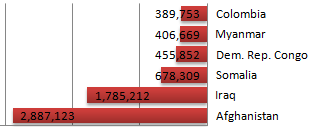About Refugees & Internally Displaced Persons (IDPs)
Today, 43 million people around the world have fled armed conflicts and are searching for safety (see Refugee/IDP Snapshots). They are children, women, and men living in temporary shelters, camps, or shanty towns, struggling to survive in new and often hostile environments. Those who have sought refuge in another country are refugees, a status which entitles them to certain rights under international law.
Those who are seeking refuge within their own countries are officially called internally displaced persons (IDPs). They have fewer rights than refugees, yet make up almost two-thirds of the people around the world today who are seeking safety from armed conflict and violence.
15.2 Million People are Refugees.
More than half are from these six countries.*
* refugees under UNRWA mandate not included

27.1 Million People are IDPs. Close to half are from these six countries.*
* IDP’s under UNHCR mandate only.

NB: In addition to refugees and IDPs, there are 1 million asylum seekers worldwide.
About Refugees
What is a Refugee?
A refugee is a person who has crossed a national border to another country to escape conflict or persecution. According to the United Nations High Commissioner for Refugees (UNHCR), there are 15.2 million refugees in the world today.
Often, they have made it just across the border into a neighboring country, along with tens or even hundreds of thousands of others: such as the Sudanese from Darfur living in camps in Chad; the Iraqis living in overcrowded urban areas in Syria and Jordan; and the Lao Hmong held in a camp just across the border from Laos in Thailand. More than 83% of refugees remain in their region of origin.
Refugee Convention
Refugees should receive assistance and protection from the country to which they have fled—under international agreements signed by 147 countries. The most important of these are the 1951 Convention Relating to the Status of Refugees, which came into being to assist refugees following the Second World War, and its 1967 Protocol.
The Convention describes refugees as people who are outside of their country of nationality or habitual residence and who have a well-founded fear of persecution because of their race, religion, nationality, or membership of a particular social group or political opinion. People fleeing conflicts or generalized violence are also generally considered as refugees, and are therefore entitled to refugee rights.
Refugee Rights
What are those rights? Firstly, the governments of the countries to which refugees have fled should offer them humanitarian assistance—food, water, shelter, and medical care— and protection from violence. UNHCR is responsible for ensuring that these rights are respected, often working through its partners. It is also responsible for finding lasting solutions to refugee crises: refugees have the right to either return home when it is safe, to stay in the country where they have sought refuge, or to resettle in a third country.
While there have been some success stories—Liberians and Sierra Leonians who have been able to return home after years of civil war, for example, or the 70,000 refugees resettled in developed countries in 2006—millions of refugees remain stuck in horrendous living conditions, often facing further violence, disease, and uncertainty about their futures. They may be dependent on the assistance of local governments and local or international aid agencies to survive.
About Internally Displaced People
What is an IDP?
The majority of people displaced by conflict—27.1 million people, according to the Internal Displacement Monitoring Centre—are internally displaced persons, or IDPs. Unable to flee to another country in search of safety, they are instead seeking refuge from violence within the borders of their own countries, sheltering in makeshift camps, shanty towns, or scattered in local communities.
Six countries are home to almost half the world’s internally displaced people: Columbia, Democratic Republic of Congo, Pakistan, Sudan, Somalia and Iran. In 2009, the worst new displacements took place in countries where long-standing armed conflicts deteriorated: in Columbia, Somalia, the Democratic Republic of Congo, and Pakistan.
IDP Rights
What rights do IDPs have to protection and assistance? While IDPs in armed conflict have rights as civilians under international humanitarian law, there is no international agency with a mandate to protect and assist them. The UNHCR has extended its mandate toward refugees to include certain IDP populations, as well as people in “refugee-like” and “IDP-like” situations.
Many local and international aid agencies provide humanitarian assistance to IDPs. But for most, the situation is bleak. Since they are living within their own countries, IDPs remain under the legal jurisdiction of their national authorities, which may well be involved in the violence that they are fleeing.
Uprooted by Violence
In many countries, including Iraq, Somalia, Sudan, and the Democratic Republic of Congo, civilians have been deliberately targeted by rebels, government troops, or bandits, and have been uprooted several times in their search for safety. Women and children are especially vulnerable to violence, including sexual violence, and children are especially susceptible to disease and malnutrition.
In many regions, the violence has become too intense for aid agencies to operate, or aid workers themselves may have become targets for belligerents. Millions of IDPs living in parts of Darfur, Somalia, Iraq, and other parts of the world are surviving with little or no access to humanitarian assistance.
